{This post is sponsored by Ball® Fresh Preserving}
In the late summer and early fall when elderberries are in season, it’s the perfect time to make some homemade elderberry syrup! This syrup is not only delicious, but has powerful medicinal benefits as well.
Ball® Sharing Jars and Freezer Jars
I’m so excited to tell you about these jars!
The Ball® Sharing Jars are just gorgeous, and the perfect way to share your homemade goodies! Make some elderberry syrup for your family, and share the rest in these beautiful jars. They make gift giving easy!
(Note: Ball® Sharing Jars are NOT safe for the freezer because they have “shoulders,” but are perfect for refrigerator use!)
I’m totally loving the Ball® Freezer Jars as well! They are great to use when you just want to preserve a small batch of something, or when you have an excess that you want to save for later.
These freezer jars are BPA free and have lids that snap on and off easy! They really make preserving easy.
Elderberry Syrup Benefits
Elderberries are highly medicinal, and elderberry syrup is probably one of the best homemade herbal remedies that anyone can make.
Elderberries are an amazing immune system booster and have potent antiviral properties. This makes them particularly good at helping with colds and flus.
Using elderberries to make syrup is one of the best ways to utilize their benefits. Elderberry syrup is easy to make, and tastes delicious. Even children love it!
Elderberry Syrup Ingredients
This is a very simple recipe for elderberry syrup, so you only need a few ingredients to get started!
You can use either fresh or dried elderberries in this recipe.
Where to Get Elderberries
The main thing you will need to make elderberry syrup is elderberries of course! Both black or blue elderberry varieties will work.
But where to get them? There are a few options:
Foraging for wild elderberries is a great way to get them, especially if they are in season (generally August – September, depending on where you live).
You can also try growing your own elderberries in your backyard!
If you don’t have access to fresh elderberries, you can definitely use dried elderberries. (They do tend to go out of stock during the cold and flu season, so here is another source for dried elderberries).
What Kind of Honey to Use
When making elderberry syrup, using raw honey is best, even better if it’s local to your region. Raw local honey is full of powerful antioxidants, nutrients, and enzymes that are still intact because it has never been heated.
You can usually find local raw honey at natural food stores, farmer’s markets, or from a local beekeeper.
If you don’t have access to local raw honey, you can find high quality organic raw honey here.
Elderberry Syrup Options
The recipe that I am sharing with you is the most basic version of elderberry syrup, but there are ways that you can customize it to your liking.
Here are a few optional ingredients you can add as you’re boiling the elderberries to make the final syrup more beneficial (and more delicious in some cases):
Ginger – either fresh or dried. This gives it a nice flavor, and also had benefits for the immune system.
Cinnamon Stick – just like with ginger, adding a cinnamon stick makes it taste delicious and has some immune system benefits.
Whole Cloves – mostly for flavor, whole cloves also have some health benefits.
Echinacea Root – gives an extra boost to the immune system, but echinacea doesn’t taste great.
Rose Hips – high in vitamin C, rose hips can be foraged in the fall, or purchased dried.
Lemon – some lemon juice and/or lemon zest can be added for flavor and to boost vitamin C.
Elderberry Syrup Recipe
While this syrup is easy to make, the most difficult part is preparing the fresh elderberries, as it takes a bit of work. You may choose to use dried elderberries to make things easier!
Preparing Fresh Elderberries for Syrup
If you are using fresh elderberries, it’s important that they are completely ripe. Any unripe or green berries can have some toxins present and should be discarded.
Elderberry stems and leaves also contain some toxic compounds, so removing as many of those as possible is also advised.
The best way to remove the stems from fresh elderberries is to first freeze them in whole clusters. Then you can either pop off the elderberries with your fingers, or use a fork to comb them off.
Don’t worry too much about any tiny stems that may remain, just do the best you can! Any toxins that are still present will be removed during the boiling process.
Making the Elderberry Syrup
To make the syrup, put six cups of fresh black or blue elderberries (or three cups dried) into a large pot with six cups of water.
This is also when you would add in any of the additional optional ingredients I listed above.
Bring it to a boil over medium heat, then lower the heat and simmer the elderberries uncovered for about one hour, or until reduced by nearly half.
It’s important to leave the pot uncovered while the elderberries are simmering, as allowing the steam to escape will help to remove any potential toxins that are present. It also helps the mixture to reduce.
If you feel like it is reducing a bit too fast, you can partially cover the pot while it is simmering.
Remove the pot from the heat and set aside to cool to a warm room temperature. You want it to be warm enough to dissolve the honey, but not too hot to preserve the benefits of the raw honey.
Strain out the elderberries using a fine mesh sieve, pressing the berries to get any extra liquid out.
You can line the sieve or a colander with cheesecloth if you prefer, this also helps to squeeze out all of the liquid from the berries.
You should end up with at least one quart of elderberry and water mixture.
Discard the berries (put them in the compost if you have one). There really isn’t much you can do with them at this point, as all of the beneficial compounds are now in the elderberry and water mixture.
Add the raw honey and stir until it dissolves. I don’t recommend heating this again, as that would destroy the beneficial compounds in the raw honey.
Ladle or carefully pour the elderberry syrup into quart jars, placing the lid and ring to finger tip tight. Let it cool completely and refrigerate for up to 6 months.
The Ball® Sharing Jars are perfect for this elderberry syrup! Not only are they beautiful, but they are wonderful for sharing and gifting.
Can Elderberry Syrup be Frozen?
Yes! Elderberry syrup can be frozen for later use. I always like to make a big batch in the fall, put some in the refrigerator, and freeze the rest.
This ensures that I will have enough to last through the whole season, even into early spring, without any spoilage.
The new Ball® Freezer Jars are amazing and so easy to use! The lids snap on and off with ease, and they are a great way to preserve smaller batches or when you don’t want to can.
Can Elderberry Syrup be Canned?
While technically you could probably can elderberry syrup, to do it safely you would need to be absolutely sure that it had the right acidity level first. It may require more acid, like bottled lemon juice, to be added first.
I generally don’t recommend canning elderberry syrup, because then all of the beneficial compounds in the raw honey would be heated, which would render them inactive.
Most of the elderberry benefits would still be there, but you would lose the benefits of the raw honey, which are also very important!
How to Use Elderberry Syrup
Elderberry syrup is powerful herbal medicine!
I recommend adults take 1-2 tablespoons of elderberry syrup 2-3 times per day at the onset of a cold or flu, and throughout the duration of the illness.
You may also take it if you feel like you were exposed to illness, even if you aren’t experiencing any symptoms yet.
I don’t recommend taking elderberry syrup daily as a preventative. It is an effective immune system booster, and while that is great during times of illness, or potential exposure to illness, you don’t want to be constantly stimulating your immune system. This is especially true for those with autoimmune issues.
Beyond being highly medicinal, elderberry syrup is also delicious and full of vitamins, minerals, antioxidants, and flavonoids! It can be used in moderation as a treat on pancakes, ice cream, or stirred into cocktails, mocktails, or tea.
Is Elderberry Syrup Safe for Children?
Yes! Elderberry syrup is safe and an excellent herbal choice for children over the age of one.
Just be sure to give children a smaller dose based on their size. For small children (ages 1-5), 1-2 teaspoons twice per day is good. That amount can be increased as the child grows.
Elderberry syrup should not be given to children under the age of one due to the raw honey.
If you haven’t started making your own homemade medicine yet, this is the perfect time to do so! And a great place to start is with elderberry syrup. It tastes delicious and has so many benefits for us!
More Elderberry Recipes
Here are some more things you can make with elderberries!
For even more recipes, see my post with 70+ Elderberry Recipes & Remedies for Food & Health!
Elderberry Syrup
Ingredients
- 6 cups ripe fresh black or blue elderberries or 3 cups dried elderberries
- 6 cups water
- 2 1/2 cups raw honey
Instructions
- If you are using fresh elderberries, discard as many stems and unripe berries as possible.
- Put six cups of fresh black or blue elderberries (or three cups dried) into a large pot with six cups of water.
- Bring it to a boil over medium heat, then lower the heat and simmer the elderberries uncovered for about one hour, or until reduced by nearly half. If you feel like it is reducing a bit too fast, you can partially cover the pot while it is simmering.
- Remove the pot from the heat and set aside to cool to warm room temperature for at least 30 minutes.
- Strain out the elderberries using a fine mesh sieve, pressing the berries to get any extra liquid out. You can line the sieve or a colander with cheesecloth if you prefer, this also helps to squeeze out all of the liquid from the berries. Discard the berries. You should end up with at least one quart of elderberry and water mixture.
- Add the raw honey while the elderberry and water mixture is still semi-warm and stir until it dissolves.
- Ladle or carefully pour the elderberry syrup into quart jars, placing the lid and ring to finger tip tight. Let it cool completely and refrigerate for up to 6 months.
Notes
- It's important to leave the pot uncovered (or partially uncovered) while the elderberries are simmering, as allowing the steam to escape will help to remove any potential toxins that are present. It also helps the mixture to reduce.
- I don't recommend heating the elderberry syrup after the honey has been added, as that would destroy the beneficial compounds in the raw honey.
- Elderberry syrup can be frozen for later use in freezer safe containers.
- I recommend adults take 1-2 tablespoons of elderberry syrup 2-3 times per day at the onset of a cold or flu, and throughout the duration of the illness.
- For small children (ages 1-5), 1-2 teaspoons twice per day is good. That amount can be increased as the child grows.
- Elderberry syrup should not be given to children under the age of one due to the raw honey.

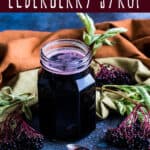
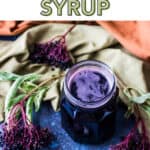
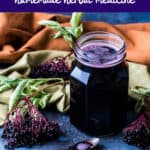
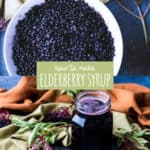
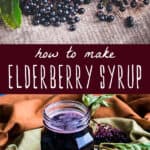
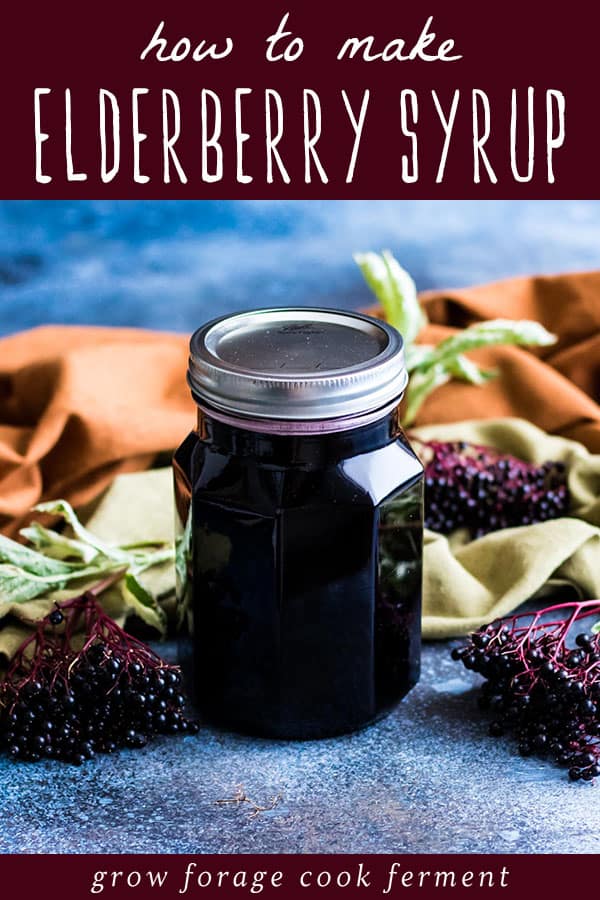
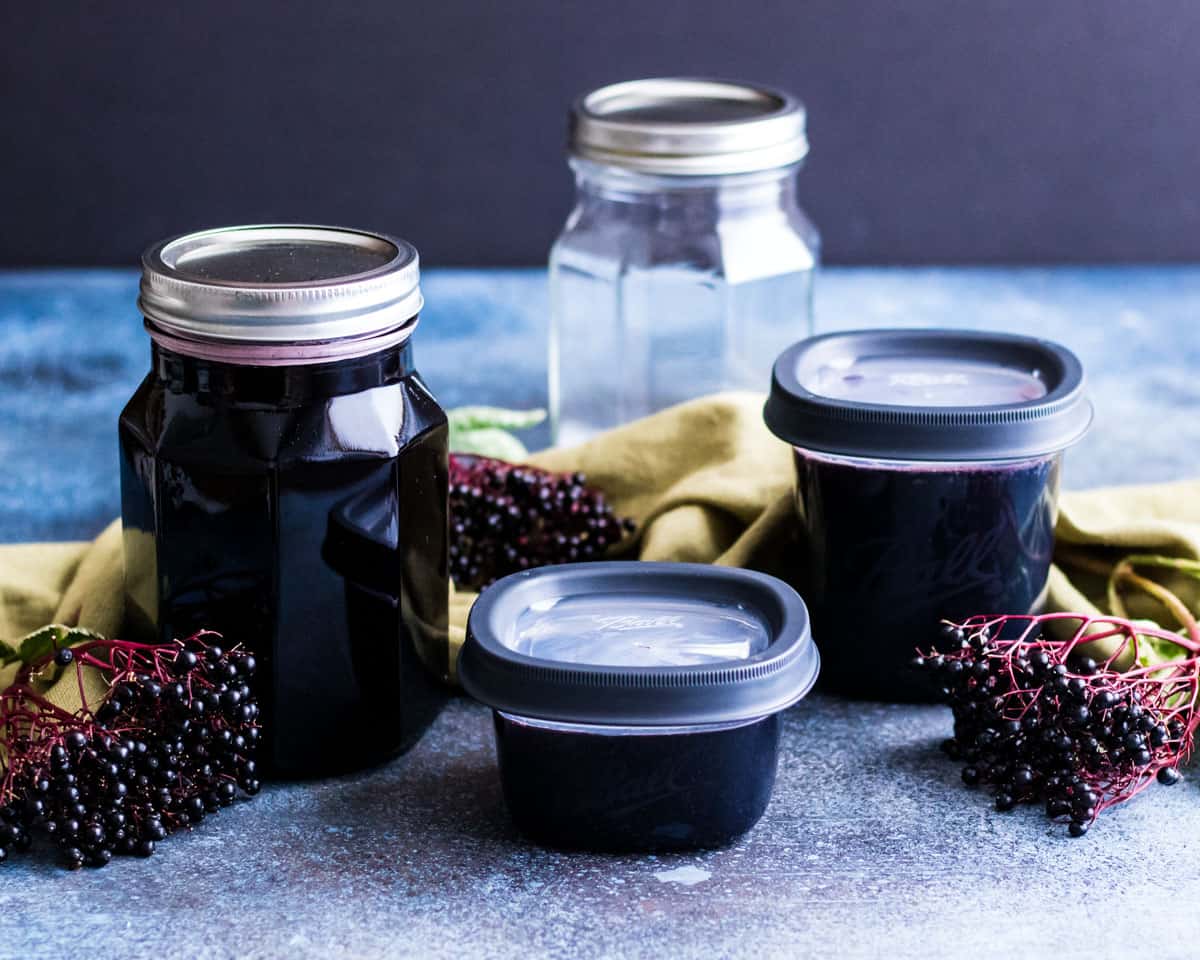
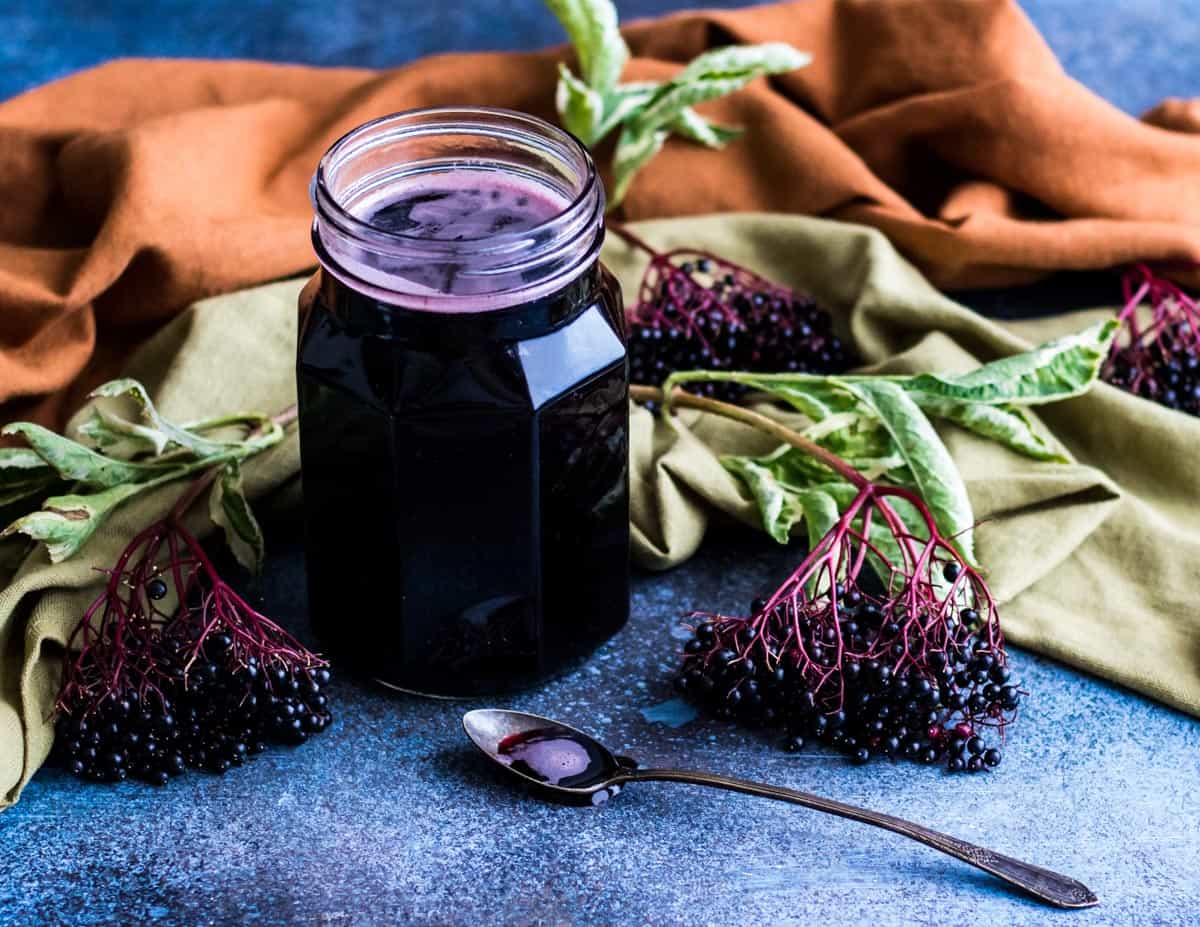
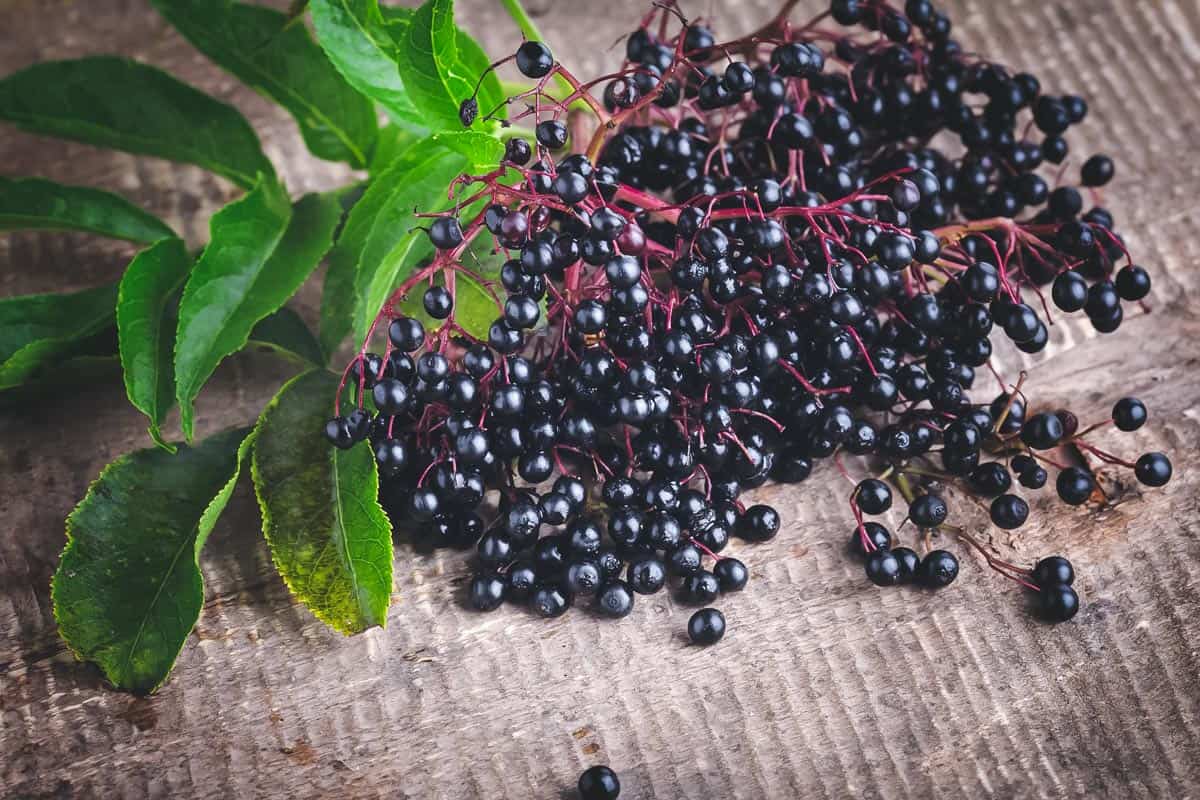
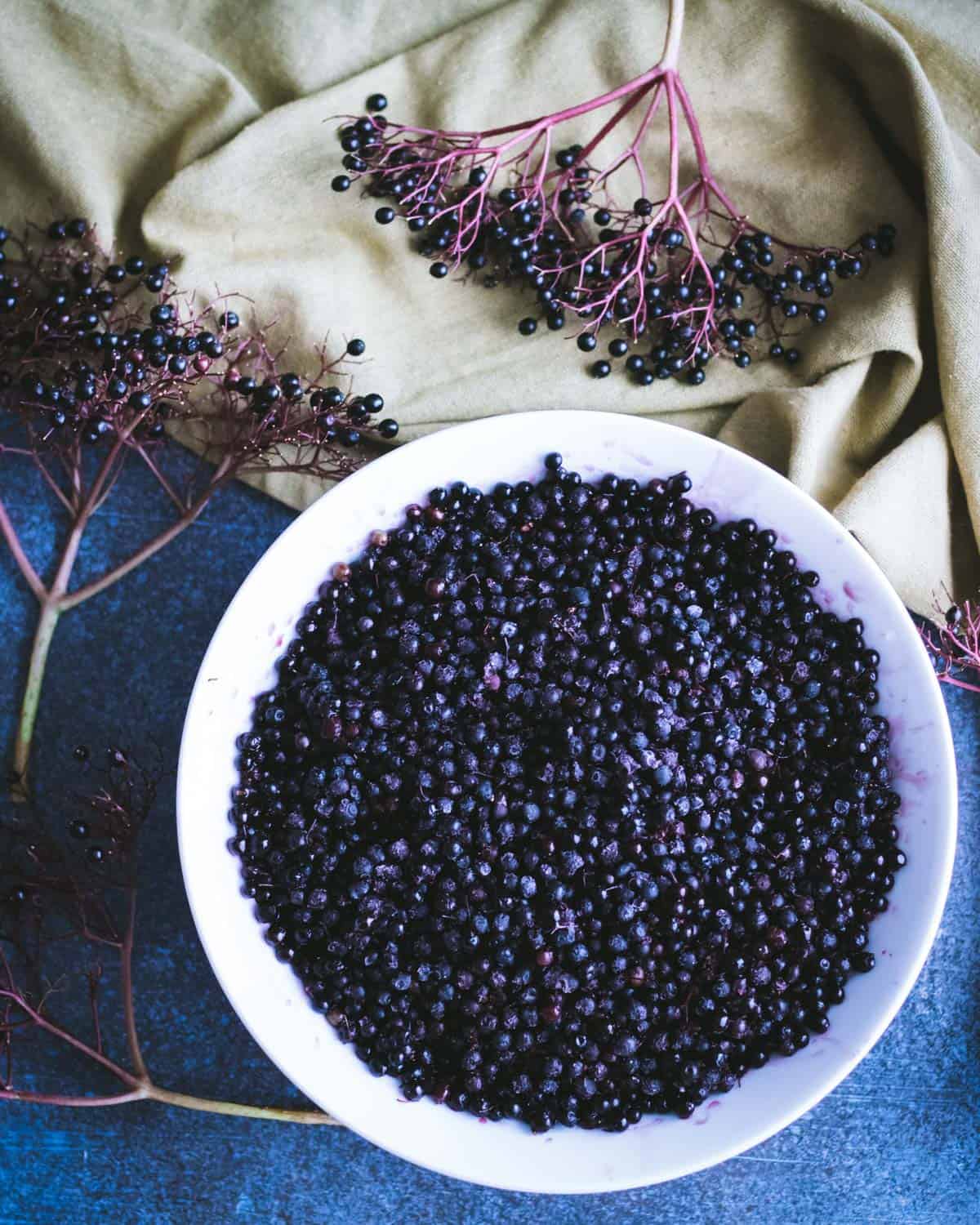
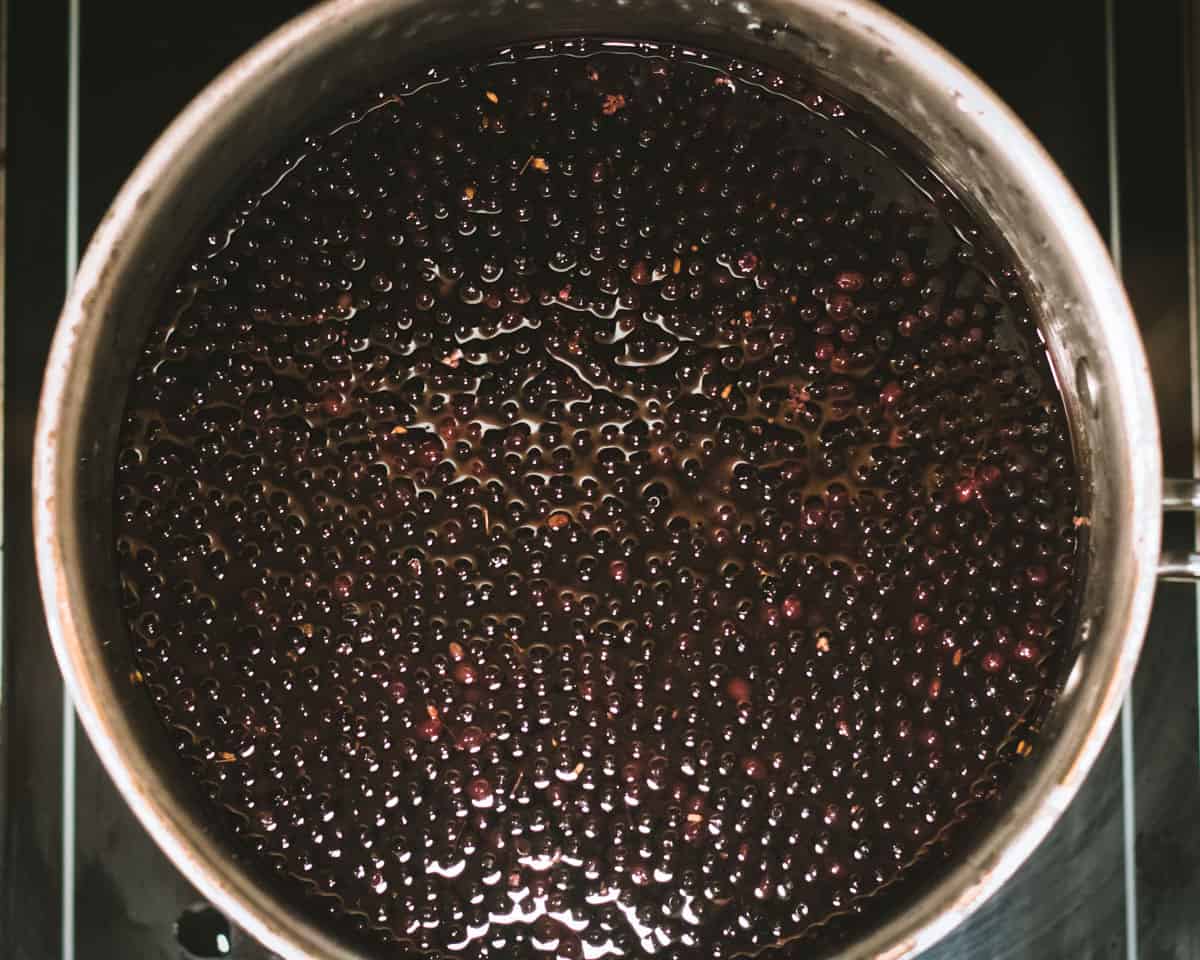
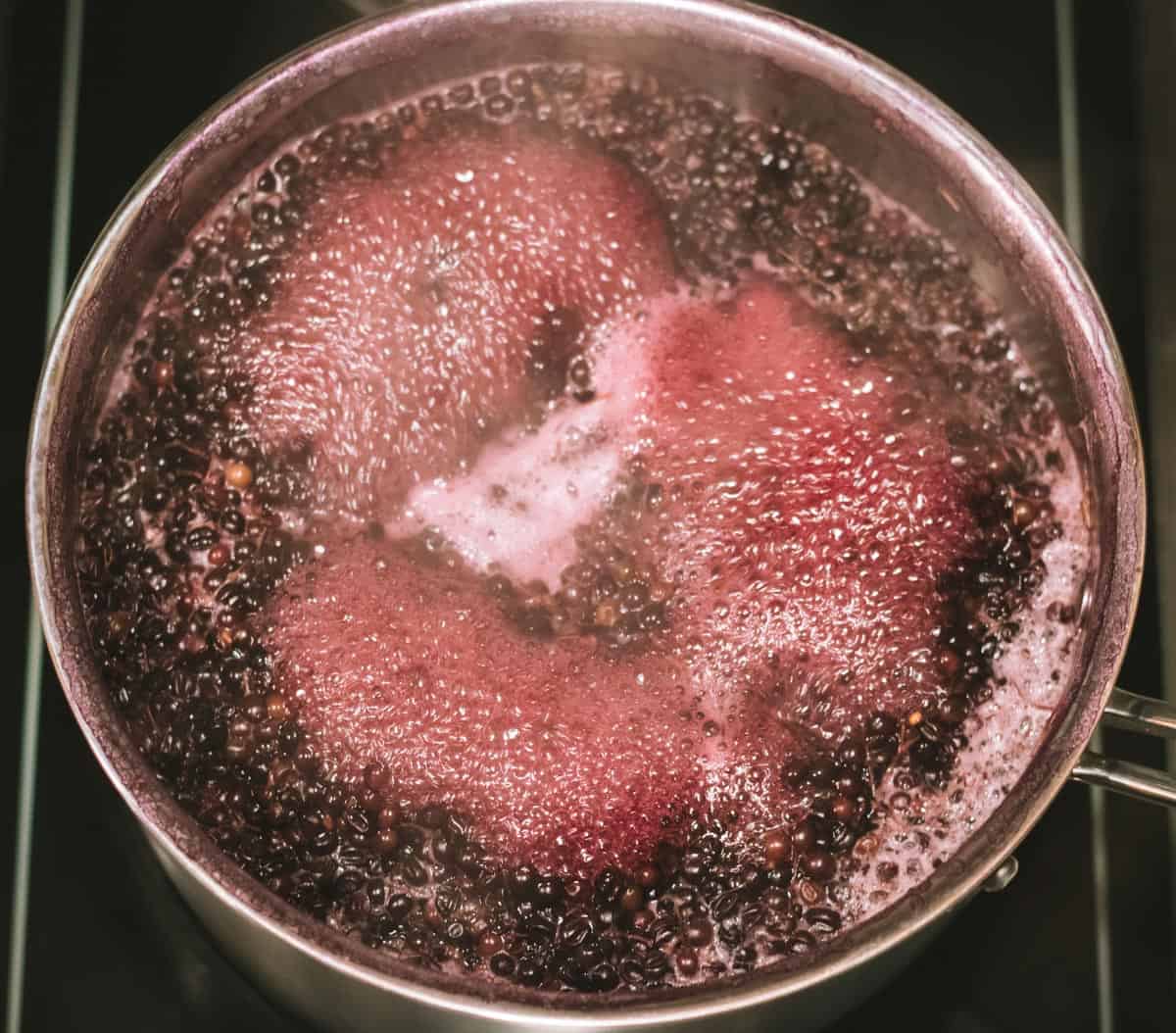
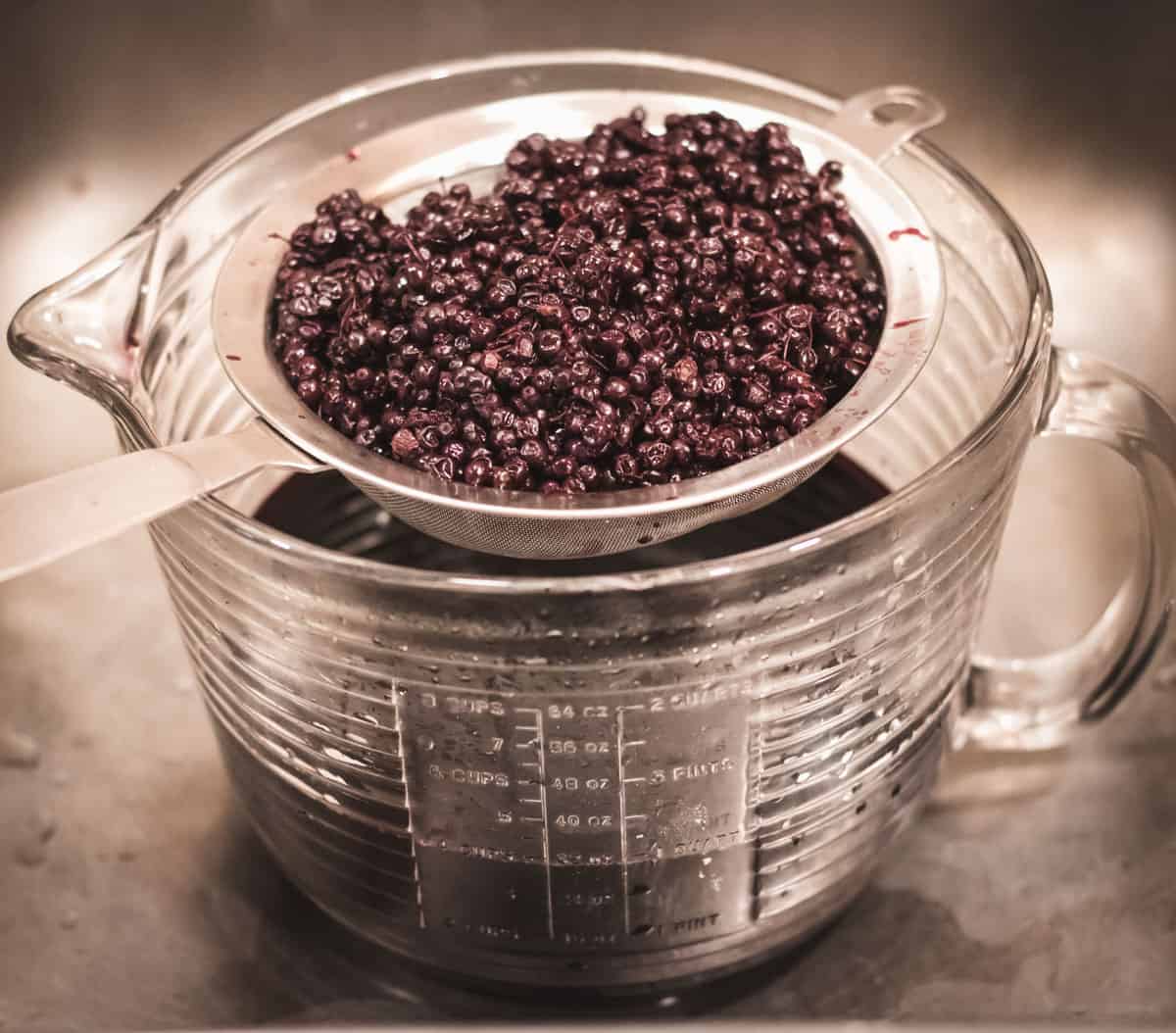
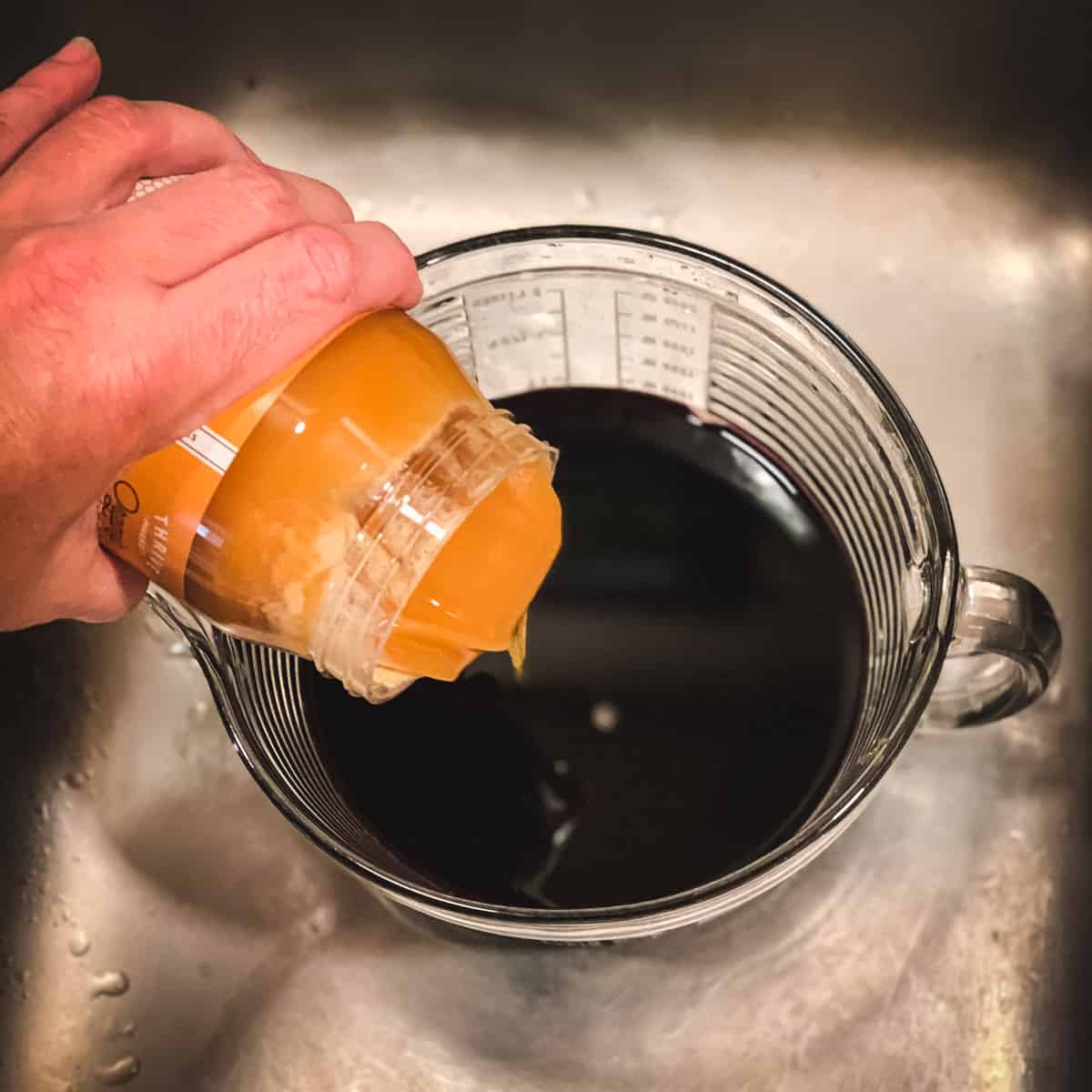
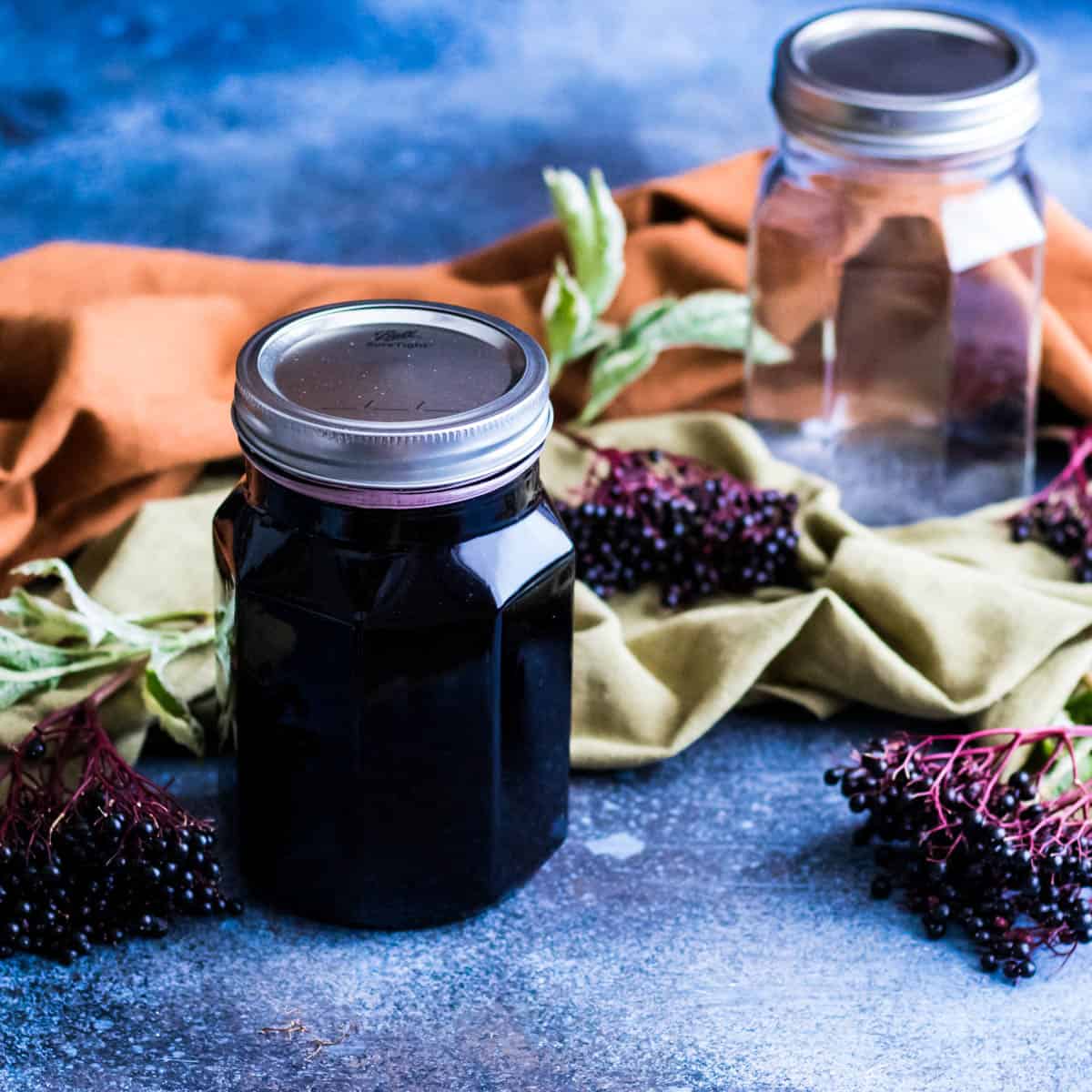
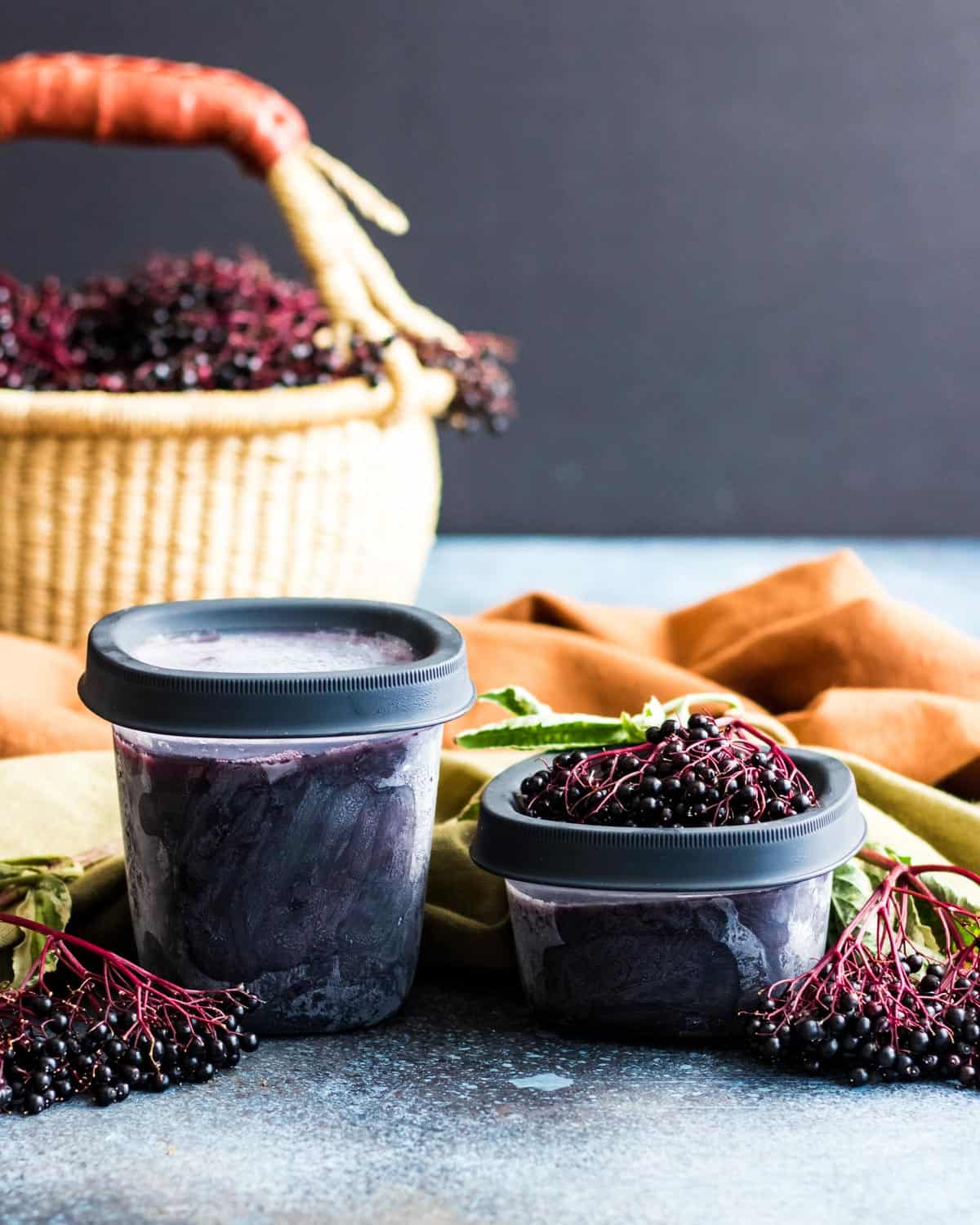
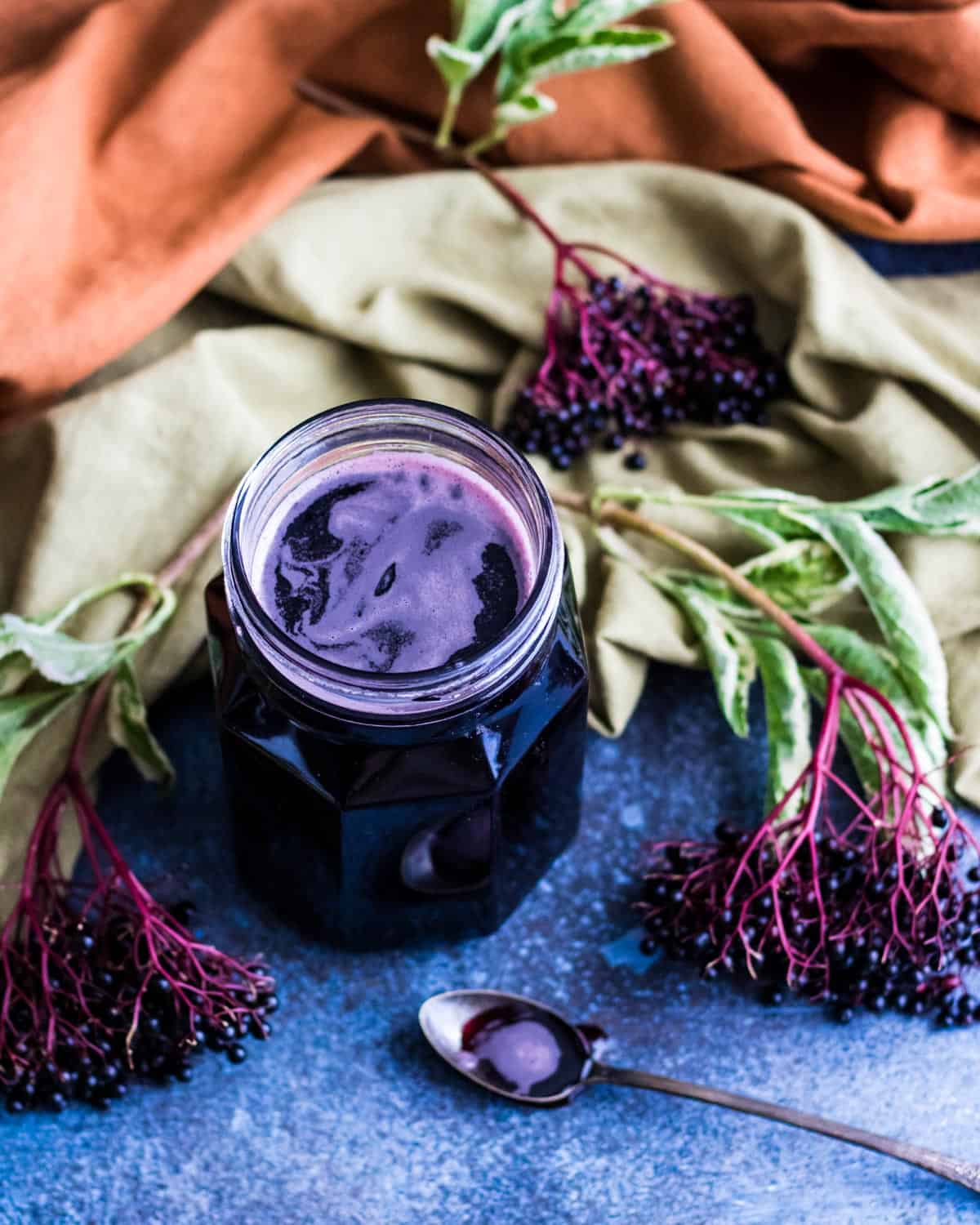
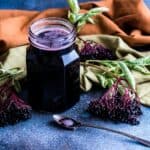

Haven’t done the recipe yet-am looking for ideas and ratios. I’ve been growing organic elderberries for several years and been making tincture, shrubs and what I call “elixir”, a mixture of tincture and honey. Because of the alcohol in the tincture this will keep years in bottles at normal temperature. Last year I steam juiced much of the crop, cooked the juice down by half and then canned it. This is the juice I want to make into syrup. It won’t have alcohol so it will have to be refrigerated and used within a few months or, as you say frozen. But I do want some without the alcohol. I think I’ll try a pint of my 2:1 juice with 1/2 pint of honey. Found your site helpful.
Thank you. Enjoy!
I made a half recipe with dried elderberries. So 1 1/2 cups berries, 3 cups water. I am left with 1 cup of liquid. Is there a ratio for honey:berry liquid? You say in your recipe to have one quart of liquid, which seems like a lot after simmering for an hour. Then add 6 cups of honey. So 6 cups honey to 4 cups liquid? 3:2. 1.5 cups honey for my one cup of liquid. Is that math right?
My daughter came home from school with a sore throat, and I’ve been wanting to make the syrup myself instead of buying it. It’s extra fun because we are reading the Herb Fairies book about the elder fairy right now too!
Thank you :)
ps. I also have a jar of honey fermented jalapenos going on my counter thanks to you!
Hi Sarah. I’m not sure where you’re getting the “6 cups of honey” from? The full recipe is made with only 2 1/2 cups, so a half batch would only be 1 1/4 cups honey needed.
Hi, could you use a instant pot with the fresh berries?
Definitely!
Hello!
I just got my dried elderberries from Mountain Rose Herbs and will be making some syrup next week for the first time. I was wondering how much ginger and/or lemon you would put in? do you find that kids like ginger or lemon better in this recipe?
Thank you so much for your sharing your knowledge with us!
Hi there. I haven’t made it with either ginger or lemon, but I would probably add a half tablespoon of ginger with the berries while they simmer and stir in a tablespoon of lemon juice with the honey.
Wonderful recipes, detailed and useful. Thank you very much.
You’re welcome!
Your photography is amazing!
Thank you so much!
I have been making wild elderberry syrup for a while. I dry some of the berries and when I have lots of them fresh I boil them as for the syrup and can the juice as is. In the winter when our smallish batch runs low I used the canned juice to quickly make a fresh batch. I heat the juice, add any flavorings that I want, then cool it to around body heat and stir in my raw local honey. We are octogenarians and are not troubled with seasonal illnesses…good stuff.
Thanks for sharing, Gail!
Hello! About how many quarts does the recipe yield? Thanks!
It yields one quart!
Are they safe to have. I see that they can be poison or be toxic. How do I know when they are good to eat
They’re safe to eat as long as they’re cooked first.
I use a steam juicer for my elderberries – so much easier!
Nice, Kelly! I should get one of those!
Hello,
My freezer is full from my Covid-19 prepping. I need to can my elderberry syrup, but am un able to find the amount of lemon juice needed per jar, or batch weight. Can you point me in the right direction? The link you provided doesn’t have elderberry in their list, and I found the sight confusing. Help!
I’m sorry. Canning Elderberry syrup isn’t something I advise anyone to do after making this recipe as the canning process will kill the beneficial nutrients in the raw honey. If you have to can, this recipe looks like a good option.
You can, can the juice without any add-ins you would normally add, then add the honey after it has cooled slightly.
If you use rose hips in the elderberry syrup ,are there additional steps you need to take ? You mentioned that hips could irritating if consumed.
Hi, Brian. You wouldn’t have to change the process much. Just cook the rose hips with the elderberries. Rose hips have hairs that are irritating to some, so as long as you strain all the seeds, hairs, and elderberries out, it’ll work fine.
I want to make the syrup with echinacea root and rose hips but I don’t know what amount of each to put in your recipe. Also, is it boiled with the elderberry, or added later with the honey?
Hi Donna, I would use only a few tablespoons of dried echinacea root, as it’s pretty strong. You can use a good amount of rose hips, but it depends on how many you have. I would say one cup is good, but this is not an exact science so do what feels right to you. They would be boiled with the elderberries.
I’ve read that agave nectar can be used, or a simple syrup made at home, but I’m not positive on the amounts.
Thank you for this recipe, I will be using it this week!
You’re welcome!
Hello…can you use golden/coconut or date sugar in place of honey as vegans will be taking it. How much to use?
I haven’t tried it so I can’t give you an exact amount to use. However, I would sweeten it to your liking with coconut sugar or see if there are any vegan-friendly elderberry syrup recipes online.